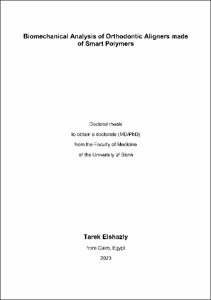Elshazly, Tarek: Biomechanical Analysis of Orthodontic Aligners made of Smart Polymers. - Bonn, 2023. - Dissertation, Rheinische Friedrich-Wilhelms-Universität Bonn.
Online-Ausgabe in bonndoc: https://nbn-resolving.org/urn:nbn:de:hbz:5-69788
Online-Ausgabe in bonndoc: https://nbn-resolving.org/urn:nbn:de:hbz:5-69788
@phdthesis{handle:20.500.11811/10628,
urn: https://nbn-resolving.org/urn:nbn:de:hbz:5-69788,
author = {{Tarek Elshazly}},
title = {Biomechanical Analysis of Orthodontic Aligners made of Smart Polymers},
school = {Rheinische Friedrich-Wilhelms-Universität Bonn},
year = 2023,
month = feb,
note = {Objective: The aim was to assess the biomechanical behavior of orthodontic aligners, experimentally and numerically, to test the applicability of shape memory polymers (SMPs).
Materials and methods: Experimentally, the design of the first study was to achieve 1.9 mm correction movement of a maxillary central incisor (Tooth 21) on a typodont using thermoformed aligners made of SMP material (ClearX) after appropriate activation steps. ClearX aligners were tested for repositioning of tooth 21 in the typodont model. The typodont was scanned after each step and the corrective movement was measured through the superimposition of scans. In the second experimental study, printed aligners made of SMPs were used (4D technology). The movement of tooth 21 on the typodont also was measured. Three point bending test (3PB) was carried out under standardized conditions and at different ambient temperatures, including 37 °C. An Orthodontic Measurement and Simulation System (OMSS) was used to measure force/deflection and torque/rotation relationships on tooth 21. Numerically, our typodont was scanned to produce a 3D digital model, which was imported into 3-matic software for designing of aligners with 4 different thicknesses: 0.4, 0.5, 0.6, 0.7 mm. The model was then exported to Marc/Mentat finite element (FE) software. A series of sensitivity analyses was performed to get the suitable parameters for FE simulation.
Results: The thermoformed SMP aligners could initiate a 1.76 mm movement, and the 4D aligners showed a movement of 2.5 mm. The maximum deflection forces were (0.5 - 3.8) N. Forces delivered on lingual displacement of tooth 21 were (0.2 - 0.7) N. Numerically, the resultant maximum forces generated on facio-lingual translation of tooth 21 were within the range of (1.3 - 18.3) N. The force was direction-dependent and was increasing with increasing the thickness. The contact normal stress map showed uneven distribution of stresses all over the facial surface and concentration at specific points.
Conclusion: Aligners made of SMPs could move a tooth by biocompatible orthodontic forces, after a suitable thermal stimulus within the oral temperature range. Additionally, a validated FE model could facilitate understanding the force systems of clear aligners and performing better treatment planning},
url = {https://hdl.handle.net/20.500.11811/10628}
}
urn: https://nbn-resolving.org/urn:nbn:de:hbz:5-69788,
author = {{Tarek Elshazly}},
title = {Biomechanical Analysis of Orthodontic Aligners made of Smart Polymers},
school = {Rheinische Friedrich-Wilhelms-Universität Bonn},
year = 2023,
month = feb,
note = {Objective: The aim was to assess the biomechanical behavior of orthodontic aligners, experimentally and numerically, to test the applicability of shape memory polymers (SMPs).
Materials and methods: Experimentally, the design of the first study was to achieve 1.9 mm correction movement of a maxillary central incisor (Tooth 21) on a typodont using thermoformed aligners made of SMP material (ClearX) after appropriate activation steps. ClearX aligners were tested for repositioning of tooth 21 in the typodont model. The typodont was scanned after each step and the corrective movement was measured through the superimposition of scans. In the second experimental study, printed aligners made of SMPs were used (4D technology). The movement of tooth 21 on the typodont also was measured. Three point bending test (3PB) was carried out under standardized conditions and at different ambient temperatures, including 37 °C. An Orthodontic Measurement and Simulation System (OMSS) was used to measure force/deflection and torque/rotation relationships on tooth 21. Numerically, our typodont was scanned to produce a 3D digital model, which was imported into 3-matic software for designing of aligners with 4 different thicknesses: 0.4, 0.5, 0.6, 0.7 mm. The model was then exported to Marc/Mentat finite element (FE) software. A series of sensitivity analyses was performed to get the suitable parameters for FE simulation.
Results: The thermoformed SMP aligners could initiate a 1.76 mm movement, and the 4D aligners showed a movement of 2.5 mm. The maximum deflection forces were (0.5 - 3.8) N. Forces delivered on lingual displacement of tooth 21 were (0.2 - 0.7) N. Numerically, the resultant maximum forces generated on facio-lingual translation of tooth 21 were within the range of (1.3 - 18.3) N. The force was direction-dependent and was increasing with increasing the thickness. The contact normal stress map showed uneven distribution of stresses all over the facial surface and concentration at specific points.
Conclusion: Aligners made of SMPs could move a tooth by biocompatible orthodontic forces, after a suitable thermal stimulus within the oral temperature range. Additionally, a validated FE model could facilitate understanding the force systems of clear aligners and performing better treatment planning},
url = {https://hdl.handle.net/20.500.11811/10628}
}






